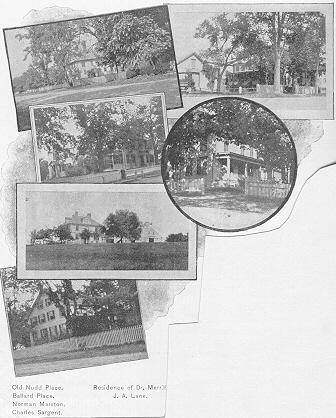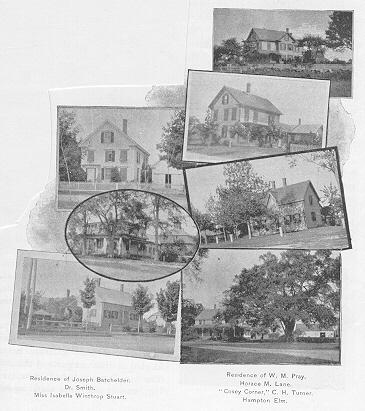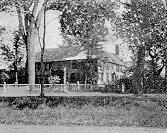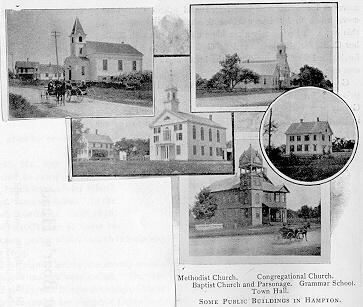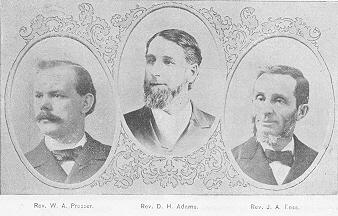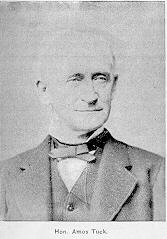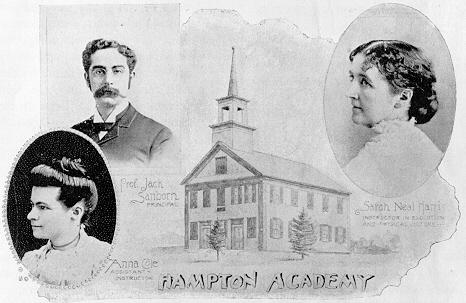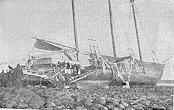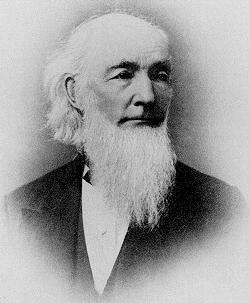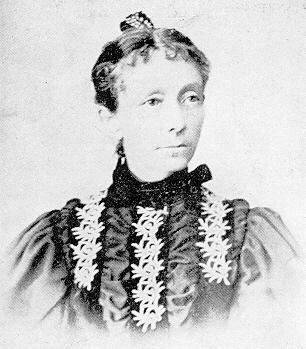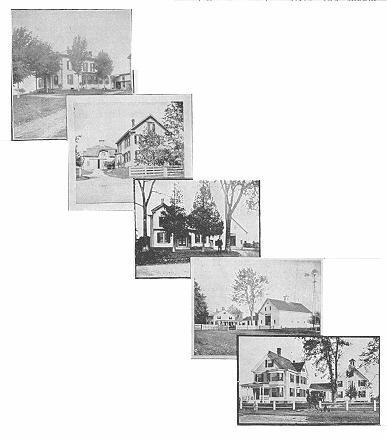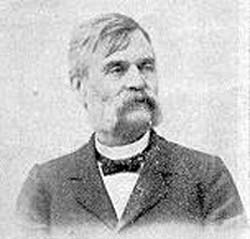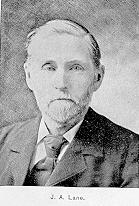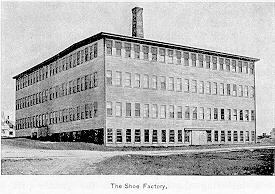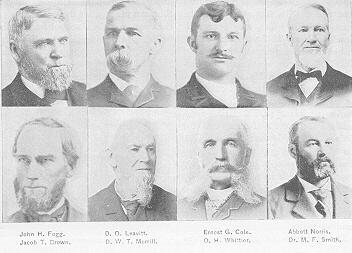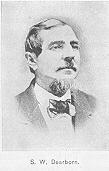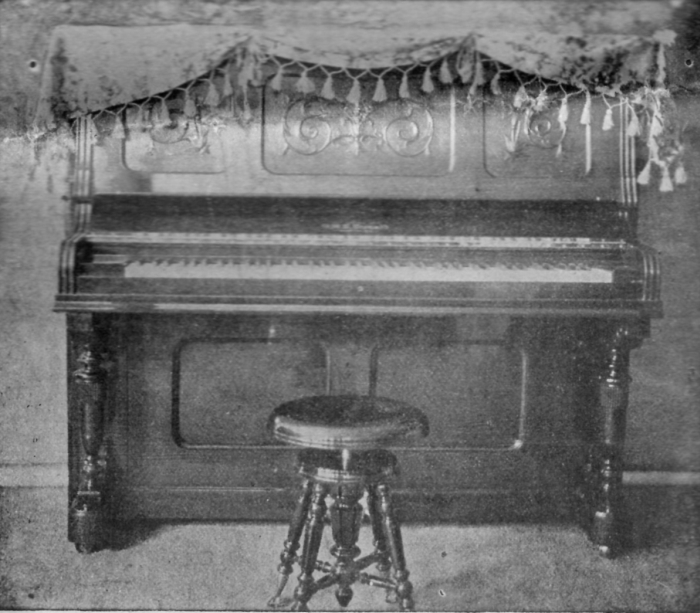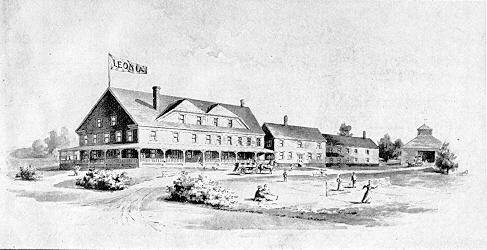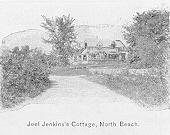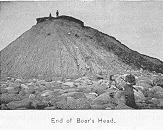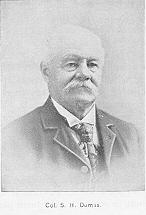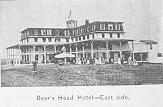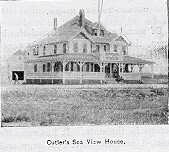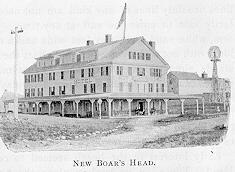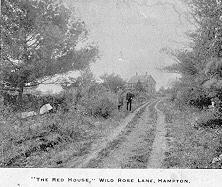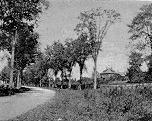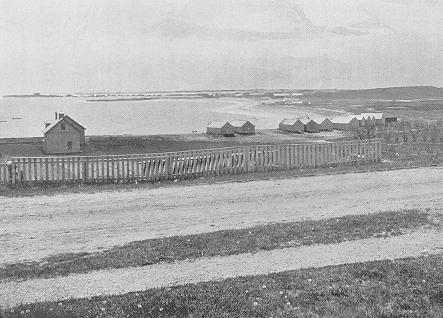By L. K. H. Lane
The Granite Monthly
Vol. XXI — July, 1896 — No. I

“What heed I of the dusty land
And noisy town?
I see the mighty deep expand
From its white line of glimmering sand
To where the blue of heaven on bluer
Waves shuts down!” — Whittier
Particular interest attaches to the early history of the beautiful town of Hampton, so charmingly situated on the Atlantic seaboard, it being one of the four original towns of the province of New Hampshire, settled the same year with Exeter, and fifteen years after Dover and Portsmouth.
More than two hundred and fifty years have been counted off by old Father Time since the smoke from the chimney of the first white settlers’ cabin, nestled among the towering pines of Winnacunnet, went curling skyward, telling as it pursued its upward flight, that a new people had come to occupy this land of the red man. Perhaps it also foretold how unequal the contest for supremacy between the whites and their dusky brothers would thenceforth be, but if so, its concealed prophesy was then uninterpreted. Yet by the end of the first century of its joint occupation by the two races, the fate of one of them, had already been told. Its numbers had decreased, slowly but nevertheless surely; the Indian had abandoned the trail, his scalping-knife no longer tortured its victim, and his wigwam had gone to decay. Only a fragmentary remnant of this once large and powerful race remained, and it offered no remonstrance to the assumption of the white man that
My rights there are none to dispute.”
Ballard Place, Norman Marston residence, Charles
Sargent residence, J.A. Lane residence,
residence of Dr. Merrill.
Winnacunnet, said to mean “Pleasant Place of Pines.” was the original Indian name of Hampton. It embraced at the time of its settlement by the whites, the larger part of the territory lying between the Merrimack river on the south, the Piscataqua on the north, and extending from the Squamscott on the west to the ocean, covering an area of more than one hundred square miles, including fully one half of New Hampshire’s seacoast. Since that time, when Hampton formed one fourth of the entire province, her territory has been greatly reduced, six towns, viz., Kingston, East Kingston, Danville, Hampton Falls, Kensington, North Hampton, and a part of three more, Sandown, Seabrook, and Rye, having been taken therefrom.
Winnacunnet was included in the grant of New Hampshire in 1629, from the Council of Plymouth to Capt. John Mason. Seven years later the first house was built there, and was known as the Bound House,” it standing on the boundary line of Massachusetts. In 1638, Winnacunnet remaining yet unsettled, the general court granted to Stephen Bachiler and others leave to locate here, and at that time the township can be said to have been practically founded. Mr. Bachiler and his associates, like the Pilgrims who landed from the Mayflower at Plymouth, were people who had been persecuted in England because of their religious belief, and sought in this new country, place and opportunity to exercise, untrammeled by obnoxious restriction and interference, the rights which they believed were justly theirs, to practice the religion of God as they interpreted it. But they were destined to experience a life fraught with privation, danger, and hardship, a recountal of which chills the blood of those who, centuries after, are enjoying the benefits resultant from their suffering.
Residence of Dr. Smith, Residence of Miss Isabelle Winthrop Stuart,
Hampton Elm, Residence of C.H. Turner at “Cosey Corner”,
Residence of Horace M. Lane, Residence of W.M. Pray.
The Indians were of course the chief cause of the settlers’ woe. In fact it may be said that they exceeded the combined force of all other adverse elements with which they had to contend, although each of itself was formidable enough, it would seem, to dishearten any endowed with less than the almost superhuman power of endurance, and determination, which was exhibited in the lives of these early pioneers. The Indians, naturally belligerent, soon became envious of the whites and a constant strife waged between them, and many a life was sacrificed to appease the morbid frenzy of the savages. From the very beginning of the settlement the whites were in constant peril. Attacks and murders were of frequent occurrence. The settler who left his cabin to work in the clearing, in doing so took his life in his hands and often delivered it up a victim to the cruel weapon of his remorseless foe, or, spared such a fate, returned to find his cabin laid in ashes and the life of wife and little ones gone out, a sacrifice to savage butchery. The founding of Hampton was prolific of such tragedy.
But the settlement grew in numbers rapidly, and in the spring of 1639 numbered some seventy-five persons, and on June 7 of that year the general court enacted as follows: “Winnacunnet is allowed to bee a towne & hath power to choose a constable & other officers & make orders for the well ordering of their towne and to send a deputy to the Court.”
During the next fall session of the general court, the Indian name of the place was changed, and the fact recorded as follows: “Winnacunnet shallbee called Hampton.” The settlers were not permitted, however, to relax their vigilance, the attacks of the Indians continuing constant and unremitting. The meeting-house which the settlers hastened to build, completed and in use early in 1639, was enclosed within a fortification, and sentinels were stationed to give an alarm should the enemy appear while the people were engaged in worship. There were garrison houses, located in different parts of the town. The old Toppan house, now standing, was at one time used as such, and was enclosed by a stockade. Verily the church was the foundation upon which the town of Hampton was reared. Of the first trees that were felled in the forest, a part were used in the construction of a meeting-house. The settlers were a devout people, and as their members increased, this meeting-house, with others that followed it, became inadequate to their needs, when each in turn was superseded by a larger and more elaborate structure.
Of the first meeting-house, but little is recorded; it was built of logs, and was undoubtedly a very rude affair, but yet served its purpose, and presumably the devotion of the worshippers within its walls was as ardent and sincere as that witnessed within the more pretentious sanctuaries of the present day, and yet it appears that there was even then a disturbing element, for in 1645 the people of Hampton made a regulation as follows: “Itt is ordered yt if any prson shall discharge a Gunn in the Meeting House or any other House, without the leave of the owner or Householder, Hee or they shall forfitt five shillings, unless the p’son so offending doth peacably make satisfaction, nor shall any prson Ride or lead a Horse into the meeting House under the like penalty.”
Another vote is thus engrossed on the town record: “To prevent danger by fire itt is ordered that if any prson shall take any tobaco, or Carrie any fire or make use of any fire in the new meeting House or the fort yard they shall forfitt ten shillings for every such offence the one Halfe to the Informer & the other Halfe to the Towne.”
Methodist Church, Congregational Church,
Grammar School, Town Hall, Baptist Church and Parsonage
The second meeting-house, which was first occupied in 1650, was without pews, having only narrow benches, and a committee allotted seats, observing the following rule: “All the men to sett at the west end and all the women sett at the east end of the meeting house and the devotion to be at the greet poest that is between the two windoes.”
The meeting-house built in 1797, the fifth in order, had “square pews” and “singing pews,” also galleries. The pulpit was a remarkable specimen of the joiner’s art, of lofty height, reached by winding stairs, and surmounted by a great sounding-board. In 1811 a steeple was built at a cost of $900, and a bell placed therein.
Rev. Stephen Bachiler, who came from England, was the first pastor settled in Hampton, his pastorate extending from 1638 to 1641. He returned to England in 1655, and died at Hackney, a village in Middlesex, near London, in 1660, in the one hundredth year of his age [This was later proven to be untrue. He actually died in London in 1656]. He was the progenitor of the Batchelders, now quite numerous in New Hampshire. Mr. Thomas I. Batchelder, of North Hampton, has in his possession several articles that have been handed down from generation to generation of Batchelders, that formerly belonged to Rev. Stephen Bachiler. One of these articles is a contribution-box that was used in Hampton’s first meeting-house. Still another is a wooden chest that he brought from England when he embarked for the new world. The advance in the religious conditions of Hampton has kept apace with the growth of the town, and there are now four religious societies in flourishing order, with attractive houses of worship, viz.:
The Congregational, the oldest church in New Hampshire, having maintained continuous existence for more than two hundred years. During that long period of time were enrolled the names of many eminent divines installed over this church. Rev. J. A. Ross is at present its honored and beloved pastor. The Free Baptist, of which Rev. D. H. Adams, is pastor. The Methodist Episcopal, Rev. W. A. Prosser, pastor, and the Second Advent, which is without a resident pastor.
The progress of civilization was rapid, the people appreciated the importance of education, and in less than ten years after the settlement of the town, a public school was established. John Legat was the first teacher, and his engagement is thus recorded. “On the 2 of the 2 Mo; 1649: The Selectmen of this Towne of Hampton have agreed with John Legat for this present yeare ensueing. To teach and instruct all the children of or belonging to our Towne, both Mayle and Femaile (wch are capiable of learning) to write and read and cast accountes, (if it be desired), as diligently and as carefully as he is able to teach and instruct them; And so diligently to follow the said imploymentt att all such time and times this yeare ensueing, as the wether shall be fitting for the youth to com together to one place to be instructed; And allso to teach and instruct them once in a week, or more, in some Arthodox chatechise provided for them by their parents or masters. And in consideration hereof we have agreed to pay, or cause to be payd unto the said John Legat, the som of Twenty pounds, in corne and cattle and butter att price currant, as payments are made of such goods in this Towne, and this to be payd by us quarterly, paying £5 every quarter of the yeare after he has begun to keep school.”
From this beginning, interest in educational matters continued, and as the town increased in population and wealth, new means and methods were adopted to improve the public school system, and Hampton became famous for its fine schools. Nearly all of its teachers before the Revolution were college graduates, and Latin was taught here in 1714. In June, 1810, Hampton academy was incorporated under the name of Hampton Proprietory school, which name was never changed by act of legislature. It soon took high rank among the preparatory schools of New England, and although less fortunate in the matter of endowment than many similar institutions, notably its neighbor, Phillips academy at Exeter, it continued to maintain an enviable record. On its list of instructors were the names of many able men, including that of Andrew Mack, its first preceptor, whose term of service was three years, Roswell Harris, A. M., Amos Tuck, Timothy O. Norris, A. M., whose preceptorship covered a period of twelve years, Joseph Dow, and others.
Hampton academy has graduated many young men who have won distinction in public life; judges, representatives, and senators in congress, railroad magnates, and governors of states are included in the number. Rufus Choate, the eminent jurist and statesman, completed his preparatory course here, as did the Hon. Amos Tuck, who afterwards was preceptor of the academy, and for many years served on its board of trustees. He was a man of recognized ability, and became prominent as a lawyer and representative in congress. He was also one of the founders of the Republican party. His ancestors were among the early settlers of Hampton, and his great and life-long interest in Hampton academy, combined with his many fine personal qualities, greatly endeared him to the people of the town.
On January 22, 1883, the academy building was moved from the site it had so long occupied on “Meeting-house Green,” to a lot donated by Christopher G. Toppan, near the town hall. A wide, public thoroughfare was laid out, connecting the two roads leading to the ocean, and named Academy avenue, on which the academy fronted. On September 14, 1885, Hampton academy and high school began its consolidated career with Prof. Jack Sanborn as principal, and he has since successfully conducted the school. The people of Hampton feel a just pride in his time-honored institution, and its alumni, scattered over the globe, cherish for it an endearing love and veneration, and the hope is entertained that the future has rich blessings in store for it, and that it will continue to occupy a prominent place among the famed educational institutions of the land.
Anna Cole, Assistant Instructor
Sarah Neal Harris, Instructor in Elocution and Physical Culture
This brief sketch of Hampton academy would be to many readers incomplete indeed, did it not contain a reference to “Grandsir Harden,” who might not inaptly be termed the beloved mascot of the school, whose humble abode, a little, one-story, unpainted house, stood for many years within the shadow of the academy building. Its latch-string was always out to the pupils of the school, and each of the great number that came and went during many years of its most prosperous career, felt an interest, reciprocated by the venerable man, that amounted almost to joint ownership in the little home. Samuel Harden was born in 1792, and died in 1877. He was a pensioner of the War of 1812, and for many years the faithful village sexton, one of whose devolving duties was the ringing of the curfew bell.
Superstition was rife in colonial days, and witchcraft was accorded undue prominence in affairs, in which Hampton shared to too great an extent, thereby producing a blot on her otherwise fair fame. There were within the borders of the town no less than a dozen persons who were called witches, and regarded with hatred and fear. Conspicuous among them was Goody Cole, whose name has been made famous by the poet [John Greenleaf] Whittier, in “The Wreck of Rivermouth,” and other poems. This unfortunate person was publicly whipped, and twice sentenced to Boston jail. After being indicted by the grand jury for witchcraft the second time, and spending several months in jail, the court rendered the following unique decision in her case: “In ye case of Unis Cole, now prisoner att ye Bar not Legally guilty according to inditement butt just ground of vehement suspissyon of her haveing had famillyarryty with the devill.
in the name of the rest.”
She was thereupon liberated and returned to Hampton, where the remainder of her days were passed.
There are strange legends concerning this eccentric character, and her shadowy life has been made the subject of many a story, interwoven with fiction and embellished by fancy. To this day [July 1896], children sitting on their mother’s knee, listen to weird stories of the mysterious power exerted by this odd creature in Hampton, more than two centuries ago.
In earlier years the people of Hampton engaged in commercial as well as agricultural pursuits, and the privileges afforded by the waterway of Hampton river were utilized for the purpose of traffic with other seaports, and by means of the shallop at first, and later by larger and more pretentious vessels, trade was carried on with Boston, the West Indies, and other foreign ports. Vessels were built in Hampton and sailed thence commanded by Hampton men, and manned by sailors of the town. Hampton was at one time dignified as a port of entry, and in April, 1696, Nathaniel Weare, Esq., was appointed naval officer there, “to enter and clear all vessels for what goods imported or exported and to receive all duties & imports, as by Law.”
Of the more prominent ship builders of Hampton, those who acquired a large compentency from vessel traffic and fishery, were Col. Christopher Toppan, David Nudd, and John Johnson.
The schooner, William Tell, belonging to the last named, made fifty-two trips in one year from Hampton to Boston and return, one each week. The schooner, Harriet Neal, owned and commanded by the same party, made two voyages to the West Indies. In 1849 she took a hundred passengers to Chagres on the Isthmus of Panama en route to the gold mines of California.
The rocky formation of portions of Hampton’s sea-coast make it a dangerous shore that is much dreaded by mariners, and upon which many an unfortunate craft has been driven to destruction. On Sunday, February 9, of the present year, [1896] the three-masted schooner, Glendon, coal laden, from Port Johnson, N. Y., to St. John. N. B., during a terrible snow storm was wrecked near Boar’s Head. The crews of the Rye Beach and Wallis Sands life-saving stations were summoned by telephone, and brought their life-boat and other apparatus a distance of six miles, over hard and badly-drifted roads. After a long and very nearly fatal delay, a line was fired across the doomed craft and being secured by the almost exhausted sailors, their entire number of seven men were taken off by means of the breeches buoy. One of the most notable wrecks here was that of the British steamship, Sir Francis, in February, 1873. The frequency with which wrecks have occurred here has demonstrated the importance of having a life-saving station on Hampton beach, a matter that has been too long deferred. Senator Gallinger has recently introduced a bill in congress favorable to that end, and already the establishment of such a station is an assured fact.
During the perilous times of Indian wars, when the fate of the colonies was problematical; in Revolutionary days, while struggling for independence and the casting off of the yoke of British oppression; and through the dark years of the Civil War; — the brace men of Hampton were foremost in volunteering their services in defence of their country and the blessed cause of freedom, and their heroic actions and deeds of valor are accorded the highest honor within the power of the people to give, and are worthy of emulation by all coming generations.
Space will permit of only a brief allusion in this article to a few persons whose names have been prominently connected with the history of Hampton. General Jonathan Moulton was born July 21, 1726, and died September 18, 1787. He took an active part in the Indian wars, and also in the Revolution; was rich in lands and cattle, and transacted a large commercial business. His house is yet standing, a conspicuous object of interest to tourists and to students of the history of “the times that tried men’s souls.”
Col. Christopher Toppan, who was born January 18, 1735, and died February 28, 1818, was a man of great intellect and fine educational attainments; was engaged in shipping and mercantile pursuits, served as a representative, senator, councillor, and two years as one of the justices of the court of common pleas.
The name of Joseph Dow will long claim honorable remembrance. He was born April 12, 1807, and died in 1889; a learned man who graduated at Dartmouth College in 1833. He wrote the history of Hampton, a most valuable and comprehensive work, published in 1893. In this labor he was ably assisted by his daughter, Lucy E. Dow, whose death occurred since the advent of the present year.
S.W. Dearborn, Clarence T. Brown,
John H. Fogg, Moses W. Brown
Uri Lamprey, who died in 1881, aged 72 years, was during his life a prominent man in public affairs of town, county, and state, and a politician whose influence was recognized far and near, and although a member of the Democratic party, the minority party in Hampton, he held many town offices. He was a delegate to the constitutional convention in 1850, represented the town in the legislature, and was a member of the executive council. He was a man of great natural ability, and possessed the qualities that made him a leader among his fellow men. By some he was termed a dictator, so great was the influence he exerted over certain numbers of the inhabitants, who, as one party put it, “thought him a bigger man than old Jackson,” and associated him in their minds as connected with all passing events, illustrative of which we will relate the following anecdote:
One day in the autumn of a certain year, an advertising team drove through some of Hampton’s principal streets, including the one to Boar’s Head, and painted on fences and rocks the letters “T L,” for the purpose of exciting curiosity, and to cause people to inquire as to their meaning, while another team was to follow some days later, and supply the missing letters of the two words, which when completed was the name of a patent medicine. Two gunners who had during the night gone down to the shore and out on a gunning trip off Boar’s Head, when they came in in the morning and started for their homes up town, loaded with ozone which was blown over from the classic shades of Newburyport, first saw the mysterious letters referred to and wondered what they meant; and as each pair of bars on the way up was reached, on every one were the mystic symbols, before which they stopped, queried and commented at such length that their journey home threatened to consume the greater part of the day. But the mystery only deepened. “What can the letters mean?” At last one of them threw up his hands and shouted, “Hurrah! I have it: T for Uri, and L for Lamper. Oh! holy, how plain I see it.” The days of Uri Lamprey are now no more, but the quaint saying, “T for Uri, and L for Lamper,” is a common proverb in Hampton to-day.
Top right: Beach’s Cottage
Center: Cottages of A.L. Joplin, W.H. Carter, C.R. Mason
Bottom left: Dr. Mitchell’s Lodge
Bottom right: Manchester Cottages at Hampton
Hon. Thomas Leavitt, judge of probate for Rockingham county, is a Hampton man by birth and education, and is devotedly attached to the old town. The Toppans, the Shaws, the Marstons, and the Towles, have all been prominent families in Hampton for generations past.
To Rev. Jesse Appleton, D.D., settled over the Congregational church here from 1797 to 1807, and who later was president of Bowdoin College, a daughter was born in Hampton, Jane Means, who became the accomplished wife of President Franklin Pierce, and as the first lady of the land presided over the White House with a dignity and charming grace that reflected honor upon herself and the town of her nativity.
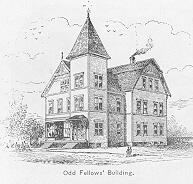
Of secret and fraternal societies in town, that of Odd Fellowship occupies the more prominent place. Rockingham Lodge Number 22, I.O.O.F., was instituted at Hampton Falls in 1848, and removed to Hampton in 1883. This lodge now numbers 170 members, and is one of the most prosperous in the state. It has recently erected and completed a large and elegant building of colonial style of architecture, to be dedicated to the use of the fraternity. Winnacunnet Rebekah lodge and Hunto Encampment, are both prosperous branches of the order. Winnacunnet Council, Junior Order United American Mechanics, another fraternal organization, has a membership of 100.
Hampton has a public library in a flourishing condition, established in 1881, and now numbering more than two thousand volumes.
A general store was opened in Hampton in 1786, by Elisha Johnson. Two rooms in his dwelling-house were used for store purposes — one for groceries, the other for dry goods. In the latter a bed was utilized for a counter. “Uncle ‘Lisha,” as he was familiarly called, was proverbially honest and generous, and treated others as being the same. He never had locks on his store doors. He transported his goods from Boston, first in whaleboats, and afterwards in larger vessels which he owned.
It is related that on one occasion the captain of one of his schooners purchased a cargo of goods of a firm in Boston, with which he had not previously traded. It being in the days before mercantile agencies were established, the firm became uneasy about their new customer in New Hampshire, and sent one of their number by stage to Hampton, to look after what they feared was a bad sale. The time that had elapsed was but three weeks, and goods in those days were sold on six months time, hence Mr. Johnson was not a little surprised when waited upon by the representative of the Boston firm, but he quickly sized up the situation, and asking his caller into the other room, pulled from under the bed a china receptacle filled with golden eagles, and counting out the amount of the bill handed it to the astonished merchant, who was profuse in his apologies and solicited another order, but “Uncle ‘Lisha” good-naturedly told him he would not cause him further anxiety, and he never afterwards patronized that firm. He amassed a large competency, and business was continued at that stand by him and his successors for more than one hundred years.
Of the merchants now in business in Hampton, the firm of J. A. Lane & Co., established in 1848, is the oldest and, as general traders, they do an extensive business. There are other well-kept grocery, hardware, drug, dry goods, millinery stores, etc., all conducted by enterprising and prosperous firms.
J.W. Mason’s Store and St. John’s Hall
D.O. Leavitt’s Store
Although Hampton has superior railroad facilities, it has developed no particular manufacturing enterprise. The shoe business flourished for a time, and some three hundred hands found employment in the large factory on the “new road,” which was built with local capital, and the quiet old village took on an air of surprising activity. The building boom was something before unknown, and owners of corner lots wore complacent smiles, and entertained exalted ideas of the value of their possessions, but all at once the shoe business here stopped, like “Grandfather’s Clock,” never to go again, and the big factory has for years remained in a state of innocuous desuetude.
Marston & True manufacture, by steam, specialties for the use of carriage manufacturers.
Abbott Norris.
Bottom, l. to r.: Jacob T. Brown, Dr. William T. Merrill,
Otis H. Whittier, Dr. Marvin F. Smith.
A new industry here is that of piano-making, established the present year by Moses W. Brown, an artisan skilled in the business, having been engaged for years with one of the leading piano manufacturers of Boston. Mr. Brown manufactures high-grade pianos in all styles of finish.
To the summer boarding business, however, must be awarded the palm as the leading industry of Hampton, as it is elsewhere throughout the Granite state.
In 1654 the first public house, or ordinary as it was then called, was opened in Hampton by Robert Tuck, who was allowed by the county court “to sell wine and strong water.” Other public houses, from time to time, succeeded this one, and about 1735 Lieut. Jonathan Leavitt opened a tavern in the village, on the site of the present Hotel Whittier, which latter structure was erected in 1816. Thus it will be seen that for a period covering more than one hundred and fifty years, this famous corner has been a place of entertainment for the traveller on business or pleasure bent, and there is no more popular house to be found to-day than Hotel Whittier, or a more genial host than its landlord, Otis H. Whittier. This house is largely patronized by summer guests, and in winter by sleighing parties as well; its favorable location, being situated about equal distance from Portsmouth, Exeter, Amesbury, and Newburyport, makes it a most attractive Mecca to which the youthful pilgrims journey by cutter and barge, during the cold and biting days and nights of winter, in search of the pleasure that can always be found in the music halls, and at the festive board of the Whittier. 
The attention of tourists was early attracted to Hampton, and quick discernment revealed the fact that Nature had not been chary in bestowing her beauteous charms upon this section of the universe, termed by one enraptured visitor, “The garden-spot of New England.” Hampton North Beach with its wild surroundings is a most captivating retreat, where the balsamic pine and fir grow luxuriantly close down by the shore, and their fragrance mingling with the ozone wafted in from over old ocean make it an ideal resort for the seeker for health and recuperation. This locality bids fair to become most popular, and real estate here is fast increasing in value. The large summer boarding-house of Jacob B. Leavitt is located on the spot where the first beach house was built in 1800.
There are other private boarding-houses, and the new and commodious hotel, “The Leonia,” was opened the present season by F. M. Crosby, who is the proprietor and manager.
This house is delightfully situated amid romantic scenery, and is thoroughly equipped with all conveniences and appliances known to modern hotel art, and no effort is spared to make the entertainment of its guests complete. Here are to be found some very pretty and attractive cottages, including that of Joel Jenkins of Montclair, New Jersey, the wealthy inventor of the safety pin, picturesquely situated near the old mill on “Nook Lane.” [now High Street] Also the “Red house,” the summer home of Mrs. Susan B. Hill, a cultured lady of recognized literary ability, among whose published works is a history of Danbury, Connecticut, just issued. Mrs. Hill is enthusiastic in her adoration of Hampton north side.
North Beach
From Hampton shore, reaching its nose far out into the ocean, as in a vain endeavor to connect with the Isles of Shoals, is the promontory known as Boar’s Head, which has a reputation as a seashore resort that is of more than local extend. It is a strikingly odd formation of earth, thrown up by nature, with a gradual rise from the westward, to a height of sixty feet above the level of the ocean. Its surface of twenty acres is covered with velvety green grass, while its base is bathed and buffeted by the waves of the Atlantic. It is an ideal spot, with which no other on the New England coast can compare for a summer hotel. This fact was long since established, for Boar’s Head was one of the first watering places to be opened up in New England, its history as such antedating by more than fifty years that of Bar Harbor and other of the popular summer resorts of the present day.
The first hotel was built on Boar’s Head in 1819 and opened to the public one year later. It stood very near the site of the present Hampton hotel, and was conducted first, by Richard Greenleaf, and later by Uri Lamprey. In 1827 the property was purchased by Thomas Leavitt, who enlarged and otherwise improved the house, and became a very popular and successful landlord. The house was burned in 1854 and was not rebuilt until 1872, when two of Mr. Leavitt’s son, T. and J. L. Leavitt, opened the present commodious and well appointed Hampton Beach hotel, which has enjoyed a liberal patronage. Its location is exceptionally fine, from its broad piazzas a sea breeze is always to be obtained, no matter from what point of the compass the wind may blow, while every window in the house commands a view of the ocean.
In 1826 a large hotel was built on the summit of the promontory and named the Boar’s Head Hotel. It was owned by a company, and managed by different parties until finally sold, together with the Granite House, situated at the base of the Head, to Col. S. H. Dumas, who had previously conducted the Phoenix, at Concord, and other well known hotels. He immediately introduced many improvements, and made extensive additions to the Boar’s Head, and under his management it had a most prosperous career, until in 1894 it fell a victim to the devouring element, fire. Its loss was a staggering blow to Hampton Beach, but Colonel Dumas transferred his attention to the Granite House, and with commendable enterprise, remodelled and enlarged the same, fitting it with modern improvements, and had it in readiness for the next seasons’s travel. This house which has been renamed the New Boar’s Head, is a cosy, as well as roomy, house, situated close by the water, and here Colonel Dumas receives his guests with that hearty welcome and hospitality that has made him famous as “an ideal boniface.” Fire has more than once visited Hampton Beach with disastrous result, and its effect is still painfully noticeable. In 1885, the Ocean House, the largest hotel there, was burned, and has never been rebuilt. South of Boar’s Head, about midway of the long stretch of the pretty cottages that skirt the roadway as it follows the circuitous shore of the bay, is Cutler’s Sea View House, and who has not heard of this famous resort, of its fish dinners, and bird suppers, that are the delight of the epicurean? Cutler’s is to Hampton Beach, what Taft’s was to Point Shirley, and any one to be familiar with the highest degree of excellence in the gastronomic art, must have sampled the larder at Cutler’s.
The visitor to Hampton who inclines to sport with gun and rod will find ample opportunity to exercise his skill. The salt meadows afford good feeding ground for small birds, while during the late summer and early autumn the off-shore gunning is excellent, as is both fresh and salt water fishing. Then there are the Hampton clams, famed for their superior quality. One can at will go down and dig these succulent bivalves, and amid the rocks and seaweed on the shore, prepare a bake that will outrival any that Delmonico’s chef can produce.
(now Cusack Road)
Another and not the least attractive or important feature that Hampton possesses, is its hard, smooth roads with their shade of evergreen foliage. They are unsurpassed in the way of country roads, and in these days of pneumatic tires hold out inducements found by many to be simply irresistible. As a seaside resort, the place lays no claim to the excitement and glitter incident to summer life at Newport, Sorrento, and Bar Harbor, but one can journey far, and not find a more pleasing combination of scenery than that with which Hampton is adorned. Highlands upon which are finely cultivated fields, contrasting in pleasing effect, with meadows green, through which flow shaded brooks of clearest water, and broad acres of salt meadows, coursed with numberless streams, supplied by Atlantic’s ceaseless tide. A shore diversified enough to charm a disciple of Arcadia. Miles of hard, white, glittering sand, stretches of pebbly waste, over which the waves ripple with constant motion, and headlands bold and picturesque. Coupled with these attractions, is the fact that the famous White Mountain range, with its incomparable scenery, the state of Maine, with its wonderful coast, Casco and Penobscot bays, Mount Desert and numberless summer-haunted beaches, coves, and islands, and the great business centre of Boston, and New York city, are all within a few hours’ ride of Hampton in New Hampshire.
